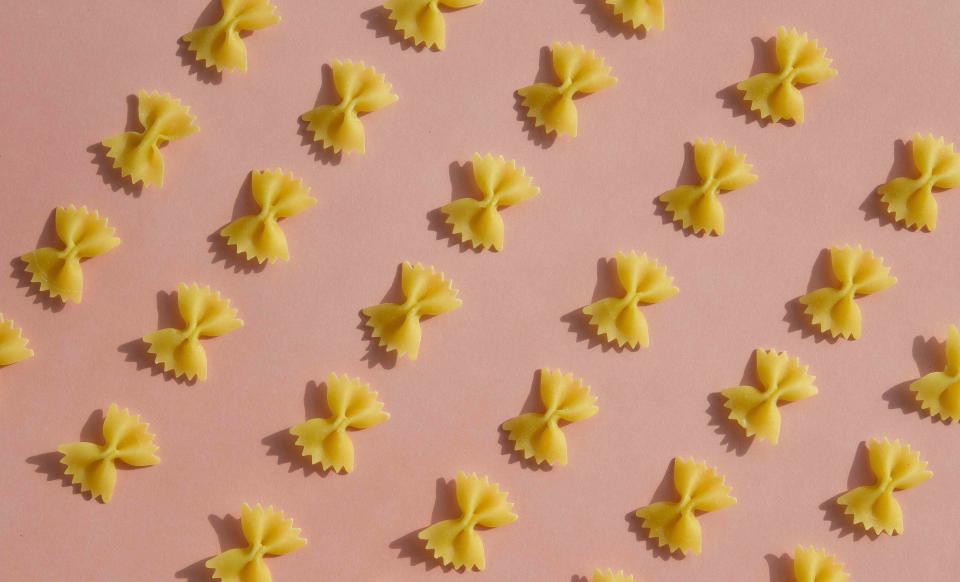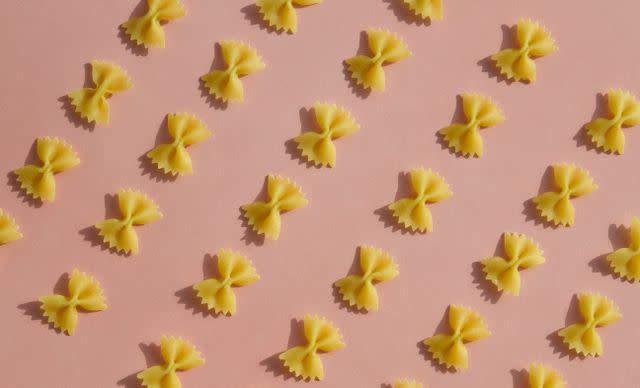How Long to Cook Pasta Based on the Shape
No one wants soggy noodles!

Bellana/Getty Images
Not all pasta cooks equally. And if you’ve ever bit into a surprisingly crisp piece of penne, or swirled up a mushy pile of thin spaghetti, you know that cooking pasta down to the specific minute can make a huge difference. Not every pound of long noodles is the same, neither is every pound of short noodles, curly noodles, flat noodles, etc. Every pasta has its own specific cook time, often shown in a range of minutes on the package.
“The cooking time of pasta varies according to two parameters—protein content and thickness,” says Antonio Rummo, President of Rummo USA, which makes premium dried pastas. “As thickness increases, the cooking time increases.” For example, penne takes about 12 minutes to cook until al dente, while a thicker rigatoni will take 14 minutes. You’ll want to use plenty of water so your pasta can swim freely (about 4.5 liters of water per pound of pasta is a good ratio) and that water should be well salted to season the pasta as it cooks.
Whether you’re boiling your water on a gas or induction stove shouldn’t matter too much – boiling water is 212 degrees Fahrenheit, no matter how you heat it. “If we take the same pot with the same amount of water and pasta and measure the cooking time on a traditional and induction hob, in the end we will have the same result with a few seconds of difference,” says Rummo. What’s most important is keeping the heat consistent and cooking the pasta in enough water so it can absorb the water it needs proportionally.

Bellana/Getty Images
Related: 8 Pasta Mistakes That Are Ruining Your Meal
When cooking dried pasta, you’re aiming for an al dente texture. That is, a toothsome bite that’s just a bit hard inside, soft outside, and texturally intriguing, to make your pasta dish Italian chef-level. Luckily, al dente cooking isn’t hard to master in any kitchen.
Ready to make some pasta? Here’s your guide to cooking times for all different types of pasta: dried, long, short, fresh, stuffed, whole-wheat, gluten-free, and beyond.
How Long to Cook Dried Penne and Short Pastas
If you’re serious about your pasta, Rummo has a method for finding your ideal cook time. “Determining the correct cooking time for short pasta can be a nice game to play at home,” he says. Start by adding penne rigate to boiling, salted water. Every minute, take out a piece and cut it in half with a smooth knife to observe the middle. You’ll see a white starchy circle, which represents the amount of starch that has yet to gelatinize, that is, become edible.
“This white circle will gradually become thinner over the minutes, until it disappears,” Rummo explains. “The time at which it disappears represents the full cooking time of the pasta.” From there, subtract two minutes from the full cooking time, and you’ll know your perfect al dente cooking time for that exact shape and brand.
Not ready to get so technical? Set a timer for one minute less than the box suggests, and remove a noodle when a timer goes off. Taste it, and continue to taste in 30-second increments until you’ve reached your desired al dente texture. Smaller noodles typically cook faster, so if you’re in a hurry, opt for a box of mezze penne, rotini, or macaroni, which can cook in just eight minutes. Large shells, farfalle, rigatoni, cavatelli, and more hearty shapes will take 10 or more minutes to cook.
How Long to Cook Dried Spaghetti and Long Pastas
Choose a pot that’s wide enough to hold your long noodles, so none of the tops are sticking out of the water when they’re added, which can cause inconsistent cooking or even burn the pasta. Once the salted water is boiling, add your spaghetti, or other long noodles, and stir, to prevent sticking. Set a timer for one minute less than the box’s suggested cooking time, stirring intermittently. When the timer goes off, test a noodle. It should be pliable, and able to twist around a fork without breaking. If the spaghetti is still stiff, give it another minute.
Related: The Key Ingredient Your Macaroni and Cheese Is Missing
Angel hair, or cappellini, is the fastest dried long pasta to cook, oftentimes al dente in just three minutes. Spaghetti typically takes 8-10 minutes. Linguine is thicker and may take 10 or more minutes to cook. Fettuccine can also take 10 or more minutes. It’s crucial to stir long noodles as they’re cooking, to prevent the strands from all sticking together and creating a lump of pasta.
How Long to Cook Whole-Wheat Pasta
Whole-wheat pasta can be made in different ratios with semolina, 00 flour, or other flours for the right texture, plus added protein and fiber. Use the package directions as a guideline, paying extra attention during the last minute or so and testing for an al dente cook. If you’ll be cooking whole-wheat pasta in sauce, opt for the low end of the cook time range, reserve some starchy pasta water, and then slowly add it in as you heat the pasta in sauce until your noodles are fully cooked through.
How Long to Cook Gluten-Free Pasta
“For gluten-free pasta, the right cooking time depends on the pasta-shape,” says Rummo. Start with the cooking time listed on the package, taste test, and go from there. If you like a softer pasta, you may want to add two more minutes. Gluten-free pasta can be made from various starches, including chickpea flour, lentils, corn, rice, and beyond, so follow the package directions based on the pasta you purchase.
How Long to Cook Tortellini and Ravioli
Tortellini and ravioli cook very quickly out of the refrigerator, about two to three minutes depending on size. Add the stuffed pastas to boiled water, and wait for them to float to the top. Stir and remove after about 30 seconds, to ensure the filling is warmed and cooked through. Try removing with a slotted spoon or spider tool, instead of pouring the stuffed pasta into a strainer, to prevent them from bursting. If you’re cooking frozen ravioli or tortellini, do not defrost. Add the frozen pasta to salted boiling water, return to a boil, and cook until the pasta floats.
Related: How to Reheat Leftover Pasta so It's as Delicious as It Was on Day One
How Long to Cook Fresh Pasta
Fresh pasta, whether homemade or store-bought, is typically quick to cook. Unlike dried pasta, fresh pasta isn’t meant to be al dente, but rather just cooked through, so it’s soft and toothsome and clings to the sauce. Thinner pastas, like angel hair, may take just under a minute to cook, while thicker noodles, like pappardelle or tagliatelle, may take three minutes. Once you add the fresh pasta to boiling water, stir it to prevent it from sticking. Then, taste test it every 30 seconds to one minute to ensure you have your ideal cook. If you’re heating it in sauce, cook the pasta slightly less than you want it to be cooked, to prevent mushiness.
For more Real Simple news, make sure to sign up for our newsletter!
Read the original article on Real Simple.

